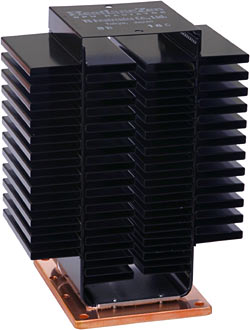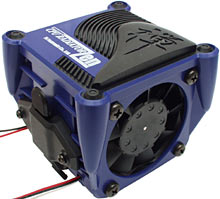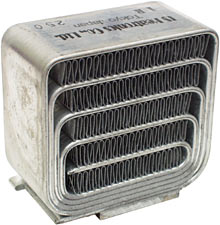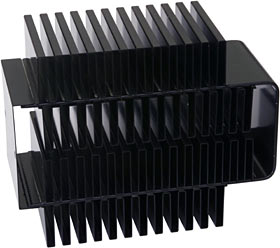
TS Heatronics NCU-1000 CPU cooler
Review date: 17 July 2003.Last modified 03-Dec-2011.
Fanless CPU cooling used to be the norm. Back in the halcyon days of the 80386, a fast processor only needed a few watts of power, and input power equals output heat; there's nowhere else to get heat from. So the CPU's heat could easily be handled by a simple knobby piece of aluminium clipped to the top of it.
If you seal an old PC's components up in an insulated box then it'd still boil itself to death fairly quickly, but if it's sitting in an office and still contains one working fan pulling reasonably fresh air over its old dusty guts, it'll be fine.
Then processors got faster and faster, and hotter and hotter. The processor speed versus heat graph isn't a straight line, or even a smooth one, but it's still left us with heat output of the thick end of a hundred watts, for high-end chips of the last few years that're working hard. More enthusiastic overclockers commonly manage to get their processors to advance the cause of entropy to the tune of more than a hundred watts per chip.
Old fashioned passive heat sinks can't cut it at these power levels. Well, not passive heat sinks that you can attach to a normal PC motherboard, anyway. A heat sink with no fan is lucky if it can handle a quarter of the heat it could dissipate if you put even a quite modest fan on it, and the bigger you make a heat sink the less effective it is per gram. Huge heat sinks have long, long heat paths from the small contact patch through which the heat is injected to all of those fins; most of the cooling gets done by the fins close to the contact patch, and the further away a fin is, the less it achieves.
What to make of this thing, then?
At a glance, it looks like a joke. Attack Of The 50 Foot CPU Cooler!
Well, the Approximately 143mm CPU Cooler, anyway. It's about half again as tall as what I previously considered a tall CPU cooler to be. So it's completely out of the question, right off the bat, for people with a PC in a slimline case - you just won't be able to get this monster in there.
Fortunately for TS Heatronics, though, their longwindedly-named HeatlaneZen CPU Radiator NCU-1000 is not a joke.
TS Heatronics made a splash - well, more of a splat, really - with their first widely noticed CPU cooler, the Zen CPU Radiator.
I reviewed the Radiator, and I hated it, because it had a design that was great for gouging motherboards and crushing CPUs, and it didn't even have the decency to perform spectacularly well. It was all right, thermally speaking, but nothing to write home about.
The Radiator was interesting, though, because it was the first mass produced PC CPU cooler to use a heat pipe. A heat pipe is a sealed tube containing a fluid that can boil at the temperatures at which it's expected to be used. You thermally connect one end of the pipe to the thing you want to cool, you connect some or all of the rest of the pipe to a heat sink, the fluid boils at the hot end and condenses at the cold end, and the result is far better heat transfer than any solid metal can manage.
(In case you're wondering, heat pipes also often have a wire mesh wick around the inside of the tube, to allow the liquid refrigerant to move uphill if necessary. Un-wicked heat pipes only work when the hot end's the low end.)
The Zen CPU Radiator's heat pipe was wrapped around in a spiral with a relatively small fin area between its coils, so it wasn't doing anything that a solid central block of copper with fins coming out of it couldn't do. Like this water cooler, the Radiator was using a fancy heat transfer method to do something that simple conduction could do just as well.
The NCU-1000 does not repeat this mistake. Its heat pipe is U-shaped, with the bottom of the U sitting on a copper plate that in turn sits on your CPU (Pentium 4 only), and the arms of the U connected to lots and lots of aluminium fins. Even the fins at the very top get to do something, thanks to the heat pipe; warm the base and the whole sink gets toasty.
It needs to get toasty, too, because the NCU-1000 is meant to work without a fan. Convection, and whatever breeze it gets from case cooling fans, are all it's supposed to need to cool P4s running at up to 2.8GHz.
Trying it out
The NCU-1000 comes in the time-honoured Pile Of Parts configuration. It has to, because TS Heatronics don't know which way round you're going to want the base plate to be assembled. The solid copper heat spreader is clamped to the bottom of the heat sink (with supplied thermal transfer goop in between) by a "presser" plate attached with four screws, and there are two sets of holes for those screws. So you can attach the plate in two orientations. The idea is to make the NCU-1000's fins point up-and-down, so convection can work to move air through them. This means the NCU-1000's only meant to be used on motherboards mounted vertically, in tower cases.
The NCU-1000's a bolt-mount cooler; you screw it onto your P4 board through the four holes that normally hold the CPU cooler retention frame. This means you can't install it with your motherboard mounted in a case (well, unless the motherboard tray has holes that let you get at the under-CPU area). The installation process isn't too terrifying, though; there's another presser plate, and a chunky rubber gasket that fits under it to protect the underside of the motherboard from crushing and short circuits.
The instructions for doing all this are quite good. You get a little Japanese-and-English booklet with the cooler that tells you what you need to do. It also tells you to take care with the cooler, since it's not just a lump of metal. The heat pipe is pressurised, and the working fluid inside will (I paraphrase lightly) blast your head apart and then eat a fizzing green hole to the centre of the earth, if you nick the pipe and let it out.
I jury-rigged a contraption to press my CPU-simulating heater against the bottom of the NCU-1000, and started playing with it.
In the non-recommended vertical configuration, in which convection won't cool it properly, it scored a very unexciting 1.9°C/W. That's pretty much what I expected; it's quite a bit better than what a similarly mounted mid-sized aluminium heat sink manages, but it's entirely unsuitable for cooling any current P4.
Turning the NCU-1000 sideways, though, greatly increased the amount of warm air I could feel flowing up from it, and kicked its score up (well, down, technically) to 0.78°C/W. That's still lousy for a P4 cooler, but should be quite adequate to cool a 1.8GHz Celeron or low-end P4 that's working hard. No way would I count on a 0.78°C/W to keep a 2.8GHz P4 cool, though; the P4's stock cooler is sure to be good for less than 0.5°C/W.
So what's with TS Heatronics' claim that this thing's good enough for a 2.8GHz P4?
Well, they use some weasel words on their page for it - "NCU-1000 is designed with maximum CPU load as e-mailing, internet browsing, using word processor, spreadsheet software or equivalent", which can be translated as "This cooler will keep a fast P4 cool as long as you don't ever do any tasks that need a fast P4".
They also compare the NCU-1000 with three other coolers identified only as "other manufacturer's fanless P4 cooler", followed by the country of origin. Way to lay it on the line, guys.
But the situation's not quite as bad as it sounds, because my tests didn't include any forced air movement. In a real computer, there'll be some. The NCU-1000 doesn't have a fan of its own, and strapping a fan onto it defeats the purpose, but it'll benefit from the air flow created by the single exhaust fan that every plain PC has (in the PSU). Any extra air flow from other intake and exhaust fans that your case happens to have will help even more.
I tried testing the NCU-1000 with a super-quiet sub-two-watt case fan pointed at it from several inches away. And bing, there was that big forced air cooling improvement once again; it didn't take much to get the score down to only a hair above 0.5°C/W.
This was in the open air, with no computer components pre-warming the air before it made it to the NCU-1000, but the big cooler still doesn't need a lot of extra air flow to get down into the performance range of a plain all-aluminium P4 heat sink with fan.
Would it get that much air flow in your computer's case? I don't know. There are tons of different case designs out there, and lots of other variables - fan number, fan power, fan location, presence and cleanliness of foam dust filters, number and tidiness of cables, closeness of exhausts to the wall, and, of course, ambient temperature. I correct for ambient temperature in my cooler reviews, but that just means that I can do tests in summer and in winter and get the same results. It doesn't mean a cooler that's OK with a given processor with a 10°C ambient temperature (which, for reference, is considered "cold" by those of us who live in Sydney, Australia) will still be OK at 35°C (which, again for reference, is considered "a bit warm").
So I can't give you a real bottom line number for the NCU-1000's performance.
In a case with a squillion high powered fans, the NCU-1000 will probably be up there with the finest P4 air coolers in existence. But in a case like that, you might as well use a cheaper ordinary cooler for your CPU; the noise from one more fan won't make a difference.
In a genuinely quiet case - say, one with thermally controlled PSU fans that're near-inaudible most of the time, plus one low powered intake fan at the front, operating with normal shirt-sleeves ambient temperatures - the NCU-1000 is likely to give you good enough cooling for a sub-3GHz P4, provided it hasn't been overclocked to that speed with plenty of core voltage boost.
Finding one
The NCU-1000 I reviewed came from Scythe in Japan.
This place in Japan has the black "BK" model, which is the one I got, for 4991 Yen; they also have the silver "SV" version for 5239 Yen. That's about $US42.20 and $US44.30, respectively, as I write this.
TS Heatronics have their own store; as I write this, the NCU-1000's not in stock, but some possibly-evolved version of the lousy old CPU Radiator is. Go figure.
This French place seems to have the NCU-1000, but only for 79 Euros, which is nearly 90 US bucks at the moment. Yow.
Shoppers in the USA can go to Scythe's recently-created US site, where you can buy an NCU-1000 using PayPal for a not-too-steep $US54.99.
And, now, Australian buyers can get one from Tier 2 Systems, for $AU100 (on special for $AU90, as I write this) plus delivery. This is a decent deal, compared with getting one of the things from overseas.
Overall
Assuming you can find an NCU-1000, and you're not afraid of bolting something to your naked and vulnerable motherboard, and you've got enough room inside your case, this thing really is a quality mid-range P4 cooler with no fan. TS Heatronics have exorcised the ghost of their nasty old Radiator.
The "2.8GHz" thing is pushing it a little, I think, but it wouldn't be hard to get solid performance out of an NCU-1000 for 2.8GHz and faster P4s that're actually doing something all the time. You could, for instance, rig a very slow, functionally inaudible fan inside the case to make sure air keeps moving over the NCU-100's fins at a decent pace. That'd rather spoil the whole "fanless" claim, of course, but no normal PC's going to be fanless anyway. A fan that can't be heard will do just fine.
Most people have no need for the NCU-1000 at all. But if you're looking for a passive heat sink that can genuinely deal with a modern P4, this does actually seem to be one.
Review NCU-1000 kindly provided by
Scythe.
(US site here.)
Available in Australia from Tier 2 Systems.






